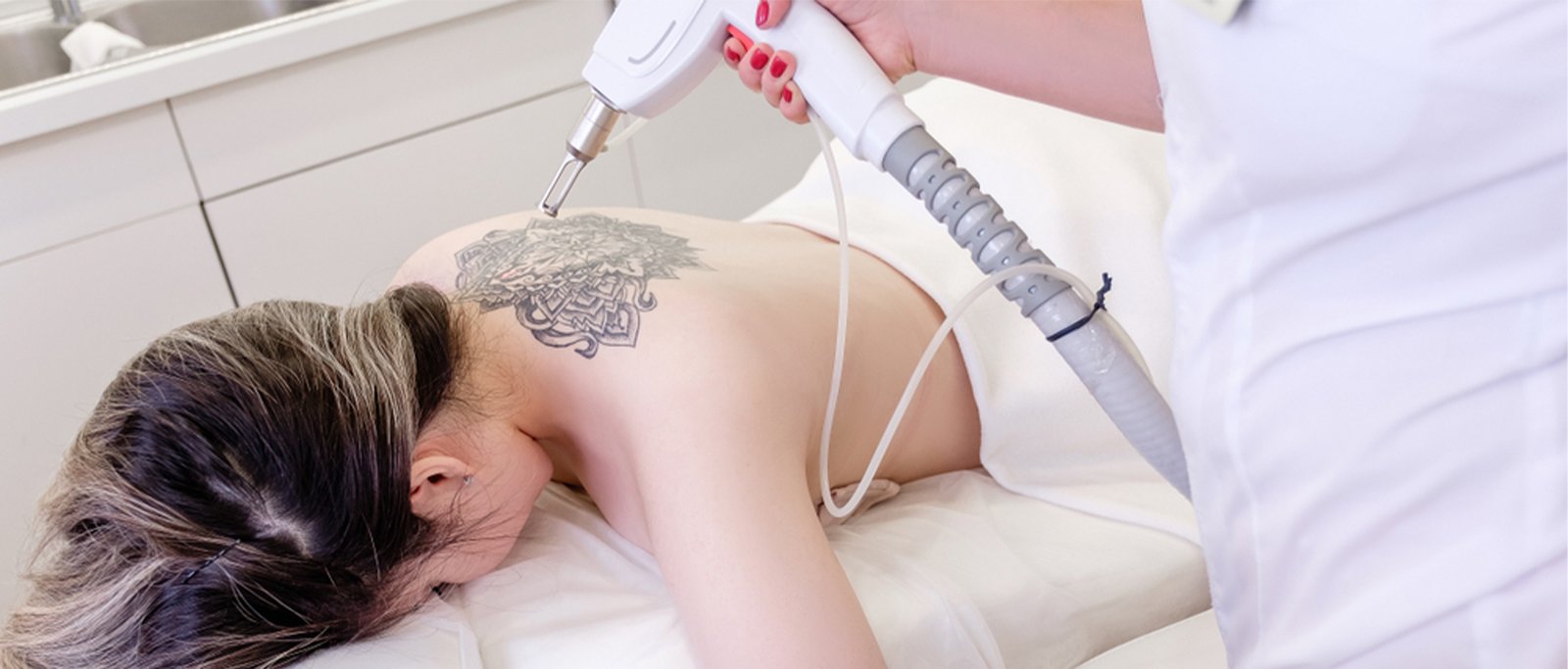Tattoos are marks driven by emotion. While tattoos can be permanent, but emotions are temporary. At any given time one may want to be disassociated with the tattoo being displayed. Earlier it was difficult to remove these permanent tattoos deeper from the skin. Many times you regret that long-time inked tattoo and you don’t love it anymore. We at Adore skin clinic have the FDA-approved, advanced technology for the tattoo removal Q-switched Ndyag is a crystal that works as a lasing medium for solid-state lasers. It works on tattoo pigment and removes unwanted tattoos with optimum results. Q-switched Ndyag has the capability to reach deeper layers of skin tissue than other types of lasers.
Types of Tattoos
- Amateur tattoos – An amateur tattoo is generally fashioned with identical colour ink such as black, brown and blue. It can be placed on an individual’s skin using a needle at home without any expert tattoo artist guidance. It is applied at varying depths and sits near the very first layer of skin.
- Professional tattoos – A professional tattoo typically comprises multiple colourings and formed using a machine and maple ink. They use highly stronger inks as compared to amateur tattoos. The colours used in this tattoo positioned to the layer under the skin is known as the dermis. These tattoos are created by professional tattoo artists at salons or tattoo parlours.
- Cosmetic tattoos – Cosmetic tattoos are also called to be permanent make-up tattoos as It involves the use of pigments into the skin resulting in soft shades which replicate cosmetics. For example eyeliner, lip liner and eyebrows which are tattooed into the skin become an everlasting form of makeup that declines the need to apply any cosmetic product on each day basis.
How will laser treatment work?
The laser emits the light that causes the tattoo particles to warm up and break down into small fragments. Then At Intervals of 8-12 weeks, the phagocytic cells of the body mop up these small particles and fade over time. Amateur tattoos normally respond rapidly to the procedure as compared to professional tattoos. Professional tattoos are tougher to remove from the skin as the ink tends to fix deeper within the skin. Bright colours that are applied for professional tattoos are tougher to remove as they don’t absorb the light quickly in the treatment. They sometimes take longer to break down and take a lot more treatments to remove than black, blue and red colors in amateur tattoos. Colors like red, orange and yellow would require more treatments. Tattoos applied in areas with minimal blood flow may additionally need more consultations.
FAQs
Laser tattoo removal usually involves some level of pain. Many of our clients say that it hurts less than what they have expected. It’s a common belief that tattoo removal is distressing, yet most patients say that the sensation of removal is less comparable to having a tattoo applied.
It requires a maximum of 6 to 8 sessions to completely remove the tattoo. The number of treatments needed to individuals depends on the size of the tattoo, the colors used and the skin type.. Large size tattoos can take 10 sessions or beyond. In order to heal the skin, sessions are spaced 6-8 weeks apart.
No single laser treatment can remove all tattoo colors. Different dyes respond to different light wavelengths. Black and dark greens are the amateur tattoos and the easiest colors to remove while yellow, purple, turquoise, and fluorescent dyes are hardest to fade as they come under professional tattoos.
The laser emits the light that causes the tattoo to warm up and break down into small particles and focus on a certain skin condition that will create heat and destroy diseased cells.
Side effects from Ndyag laser treatment are generally minor and can include:
- Pain during treatment although is reduced by contact cooling and if necessary, a topical anesthetic applied to the area.
- Redness, itching, and swelling immediately after the procedure that may last for few days after treatment
- Rarely, skin pigment absorb much light and blistering can occur ( although this settles by itself)
- Changes in skin pigmentation. Sometimes the pigment cells (melanocytes) can be highly damaged, leaving darker (hyperpigmentation) or paler (hypopigmentation) patches of skin. Generally, cosmetic lasers work better on people with lighter rather than darker skin tones
- Bruising Sensation affects up to 10% of patients. It usually fades as time passes.
Many Clients are concerned about scarring from laser tattoo removal – they normally want their skin to look as natural after they’ve completed the tattoo removal procedure. When a Q-switched laser treats the skin, it targets to break down the tattoo pigment in the skin. If pre-existing scarring is present, it will automatically break down these pigments into particles within the scar tissue. Once the tattoo removal process seems to be done, the ink will have been removed from the place but any of the scarring from the original tattoo will likely to remain for sometime and fade at its own.

